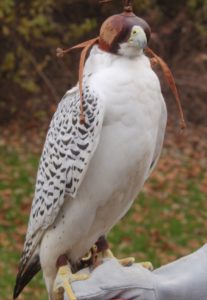Photography courtesy of Lowell Washburn, all rights reserved.
For Iowa outdoor enthusiasts, the sighting of a seldom seen bird is a rare treat. And when it comes to birding in the Tall Corn State, the sightings don’t get much rarer than when focusing your binoculars on a wild gyrfalcon. The species is such an infrequent visitor, in fact, that most birders – even the hardcores — will never receive an opportunity see a wild ‘gyr in Iowa. I’ve had the priviledge of seeing two. The first was at a distance; the second was much closer. Lance Christensen, Rob Kirkman, and I were pheasant hunting with falcons near Swaledale in Cerro Gordo County. Kirkman’s falcon had scored a ring-neck KO and we were all standing by as the hawk cast pheasant feathers to the wind. A large gyrfalcon [ya, I know — they’re all large] suddenly appeared and lit on the ground nearby. Wherever it had been, the wild falcon was an obvious witness to our flight and had flown to investigate the commotion. ‘Gyrs are among the most sociable of raptors, and the bird displayed no aggression and made no attempt to rob Rob’s falcon. Instead, the gyrfalcon merely seemed curious and eventually flew off again. That event occurred more than thirty years ago, and I haven’t seen a wild ‘gyr since. That is until last Friday when my lifetime tally suddenly rose to three.

The surprise sighting occurred near Ventura last Friday. Fellow falconer, Ross Dirks and I had been spending the afternoon pursuing rabbits with our trained goshawks. While moving between hunting spots, we spotted the giant falcon sitting atop a wooden utility pole about a mile south of town at the intersection of S14 and 237th St. Our mutual recognition was immediate. “Gyrfalcon!”, we simultaneously exclaimed. Quickly pulling to the side of the gravel, we were able to observe the magnificent bird through binoculars at a distance of around 35 yards – which was close enough to clearly see every detail, which included some dried blood on the raptor’s beak.
A resident of the high arctic, the gyrfalcon is the world’s largest member of the falcon family. Females are about the size of our red-tailed hawks. With speeds matching their size, ‘gyrs make most of their living by outflying tundra nesting ptarmigan and waterfowl. Although most of these arctic raptors are nonmigratory, a few gyrfalcons move to central Canada during winter. Fewer still drift as far south as southern Canada and the northern U.S.
Due to its large size, spectacular courage, and powerful flight, the gyrfalcon has long been held in high esteem by falconers worldwide. The ‘gyr was a favorite of Mongol Empire founder, Genghis Khan who assembled extravert caravans to conduct hunts lasting as long as two or three months which employed dozens of trained birds. During the Middle Ages, trained gyrfalcons were strictly the domain of royalty: only kings and the occasional nobleman were allowed to possess the species.
One of the most interesting stories regarding the gyrfalcon was related by late American falconer, Al Nye. During the early 1940s, Nye’s friend Luff Meredity imported a group of young gyrfalcons taken from nests in Greenland. One of the falcons [named Inga] was traded to Nye. Luff then sent one of the bird’s sisters to Europe. The bird eventually made its way to Germany where it was acquired by Herman Goering, soon to become the infamous leader of the German Luftwaffe. Following the conclusion of World War II, Nye noted that, “I’ve often wondered if Goering ever knew that the sister of his ‘gyr was being flown by a Navy Lieutenant in the United States?” Incredible!
Most of the gyrfalcons used in modern-day falconry begin life in captive breeding projects rather than arctic cliff nests. Many of these captive-bred birds are exported to the Middle East where they remain in high cultural demand.
Whether it’s a trained falconry bird or an untethered wild visitor, the magnificent gyrfalcon still commands our attention; and the sighting of a wild bird never fails generate extreme excitement. The Ventura ‘gyr was no exception. As the news spread, birders soon began combing the area where the raptor was seen. Unfortunately, no one has been able to “rediscover” the rare falcon so far.
Spirit Lake’s, Ed Thelen, was one of the birders who journeyed to Ventura to search for the elusive raptor. “I knew it was a long shot, but you never know, and I figured it was worth a try” said Thelen. “They are defiantly mobile and by now, that bird could be heading back north across Minnesota.”
With the weather breaking, the bird could indeed be long gone. On the other hand, it’s possible that the giant falcon could still be in the area – ready to bring instant cheer to the next carload of birders hoping to catch a glimpse of that magnificent ‘Falcon of the Midnight Sun’.

 Tom Cope
Tom Cope Sue Wilkinson
Sue Wilkinson Susan Judkins Josten
Susan Judkins Josten Rudi Roeslein
Rudi Roeslein Elyssa McFarland
Elyssa McFarland Mark Langgin
Mark Langgin Adam Janke
Adam Janke Joe Henry
Joe Henry Kristin Ashenbrenner
Kristin Ashenbrenner Joe Wilkinson
Joe Wilkinson Dr. Tammy Mildenstein
Dr. Tammy Mildenstein Sean McMahon
Sean McMahon